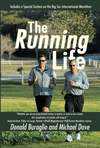Donald Buraglio and Michael Dove's Blog, page 29
April 23, 2011
Merrell Barefoot Trail Glove Giveaway Winner; Random Shots of Beauty
Since I promised a winner on Saturday and my Saturday's practically over, we'll get right down to business: Nate in Colorado, e-mail me your address - you're the lucky winner of the Merrell Barefoot Trail Glove giveaway!
To everyone else, thanks very much for your entries and comments - and be sure to check out TravelCountry.com, where the Merrell Barefoot Trail Glove is well-stocked and available for purchase. And ladies, stay tuned for a Merrell Barefoot Pace Glove review and giveaway in the very near future.
*
As for this weekend's Random Shot of Beauty, the location was a no-brainer, but the specific shot selection was a little more difficult to choose:
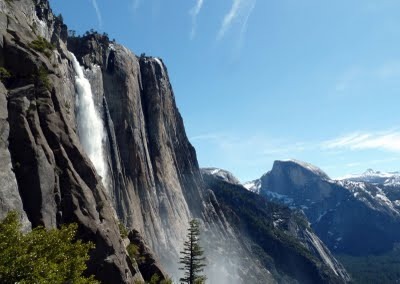
I went with the old standbys: Yosemite Falls on the left, Half Dome in the distance on the right. More details on this next week as well.
Get updates as soon as they're posted! Click here to subscribe to Running and Rambling.
Check out the Running Life book for a collection of our most popular columns.

To everyone else, thanks very much for your entries and comments - and be sure to check out TravelCountry.com, where the Merrell Barefoot Trail Glove is well-stocked and available for purchase. And ladies, stay tuned for a Merrell Barefoot Pace Glove review and giveaway in the very near future.
*
As for this weekend's Random Shot of Beauty, the location was a no-brainer, but the specific shot selection was a little more difficult to choose:

I went with the old standbys: Yosemite Falls on the left, Half Dome in the distance on the right. More details on this next week as well.
Get updates as soon as they're posted! Click here to subscribe to Running and Rambling.
Check out the Running Life book for a collection of our most popular columns.

Published on April 23, 2011 16:58
April 21, 2011
Hiking Yosemite in Vibrams: Minimalist FAQ
Today's post is something of a precursor for one to follow next week – or perhaps it's more of a long tangent that I figured would justify a post all its own.
The main story next week will be how our family spent two days hiking some of Yosemite National Park's signature trails, in conditions that would be called adventurous even by ultrarunner standards. The side story is that I did both hikes in Vibrams – just as I've done for all of my hiking over the past year and a half – and about all of the comments, inquiries, and occasional snickering that I received along the way.
 Freak feet!
Freak feet!
I've mentioned a few times that minimalist footwear is becoming a bit more commonplace in the ultrarunning community, to the point where you're not automatically considered an idiot or a freak for showing up to run 50 miles in a pair of moccasins or barefoot shoes. However, among hikers, there's definitely still a strong element of surprise and disbelief. If I had a nickel for every time I heard something like Did you see what that guy was wearing? or Oh my gosh, that guy was in toe shoes! or even some kind of smart aleck remark after I passed somebody going the opposite direction, I would have finished the hike noticeably wealthier than when I started.
I'm pleased to note that several other people didn't just make comments in passing, but actually stopped to ask me direct questions about the Vibrams - and since I ended up answering a lot of the same inquiries multiple times, I thought that a public debriefing would be useful to anyone who might come across another minimalist idiot in Yosemite someday. Because chances are, that idiot might very well be me.
So here's what I heard most frequently on the trail over the two days of hiking …
Q: Do those give you enough support?
A: This was probably the most common question I received, and it's quite clear that conventional wisdom about having a sturdy footbed and firm structure around the ankle is alive and well among recreational hikers. Of course, the proper answer is no, they don't give me any support … but that's the whole point. Unfortunately, passing someone on the trail doesn't really afford you enough time to have a whole discussion about the inherently brilliant natural architecture of the foot, so I typically summarized this point by saying "I just let the foot do the work". Which I'm sure didn't make any sense to half of the people I told, but you never know.
Q: Don't you need any cushioning?
A: If question #1 was about support, #1A was about cushioning. To be sure, Yosemite's classic trails have a huge amount of granite, often irregularly shaped and jagged, which to many hikers means you need a thick, soft midsole to absorb the impact.
 There's a trail there somewhere
There's a trail there somewhere
My answer for this was similar as the first one – I let my foot do the work – with one caveat: I do tend to "pick my line" a bit more carefully when I'm descending the steep, rocky trails than I used to in standard trail shoes. It's very similar to the accommodation I make while trail running, where I take the steep downhills noticeably slower than my previous "bombs away" fashion – but it's not as big of a difference as you might expect. I still jump down onto rocks, or bound from one jagged granite step onto another … but there's just an extra dose of caution thrown in there for good measure – which, considering that I was hiking with my kids instead of racing to get a belt buckle, is probably a good thing.
Q: Do your feet get wet?
A: Yes, definitely. Depending on the conditions, this is the one legitimate drawback to wearing Vibrams on the trail; if air temperatures are decently warm, it's not a big deal, but if it's cold outside (or if the ground is cold – see below), your toes definitely get chilled far more easily than in standard footwear. The flip side of this is that if you're doing full immersions at stream crossings, the Vibrams dry much more quickly than traditional shoes – and at Yosemite in the springtime, crossing runoff channels just goes with the territory.
 Hard to see ... but there's a stream running straight down the trail
Hard to see ... but there's a stream running straight down the trail
The only time when I had an issue with comfort was during a stretch of about 45 minutes of continuous snow; between my feet being soaked and the frigid ground sucking heat away from me, my toes got a little bit painful. Luckily, the only remedy I needed was to sit on a warm rock every now and then and let the sun shine on my black-clad toes for a while, and I was fine. But if there hadn't been rocks to sit on every so often, I would have been fairly bummed.
 Warming my toes in the sun
Warming my toes in the sun
Q: How is the traction?
A: Pretty much the same as regular shoes, but for this trip, I decided to be a little extra cautious and chose my newer pair of Trek Sports rather than my traditional standby KSO Treks, because the outsole lugs were a little more worn down on the older Treks. Between the knobby outsole and the ability of your foot to grip the ground naturally, traction has almost been a non-factor for me in Vibrams, with a couple of exceptions.
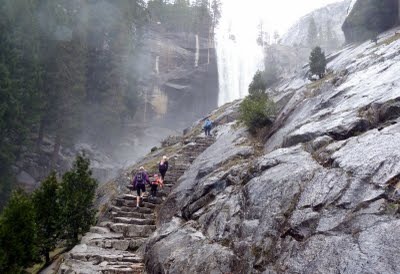 Thick mist + slick rocks + steep steps = a challenge coming back down
Thick mist + slick rocks + steep steps = a challenge coming back down
On steep descents, if the rocky surfaces are both irregular and wet, I have to be even more careful about where I'm placing my feet. If the steep descent has a lot of loose gravel, I have some occasional slipping, but I'd say it's about equivalent to the troubles I see other people having in their super-lugged SUV boots. So I wouldn't say they're slip-proof, but they're probably the equivalent of most standard trail shoes or boots out there.
Q: Don't your feet hurt?
A: The short answer is no, but I'm always careful to include something like "it takes some getting used to" or "I've been doing this for a while". Over the course of a couple of years, I'm now at the point where spending all day on my almost-bare feet on rocky trails isn't that big of a deal, but if you're a newbie minimalist and try to hike up and down some crazy rugged trails, you'll definitely get sore feet afterward. Last year, I did the Mist Trail hike in Vibrams; it was one of the first day hikes I had done in them, and I do remember having significant soreness afterward. This year, I did the same route with no problems at all. So there's obviously an adaptation curve to all this, and I don't want to mislead anyone into thinking that you just slap on a pair of Vibrams and everything's suddenly a breeze.
Q: Why do you wear those?
A: Because it's fun! Actually, check that – it's magnified fun. The same pleasure that I feel in connecting with the earth during routine runs on my home trails of Monterey County is increased about 100-fold when I'm in one of the most majestic places on the planet. Part of the joy I take in being in wilderness areas is the way I feel at one with the landscape – and when I can feel every bump, pebble, and contour of that landscape as I'm moving across it, I feel even more connected than I ever imagined.
 Overlooking the Silver Apron above Vernal Fall
Overlooking the Silver Apron above Vernal Fall
Among all of the minimalist shoes I've tested, nothing matches Vibrams in their replicating a true barefoot feel, as if they are a natural extension of the foot – and that's why they're my shoe of choice for long days of hiking. And if there was some way for me to put into words the exhilarating feeling of swinging your nearly-naked feet over the precipice of a cliff or the lip of a high waterfall, I think folks would be lined up at the door wanting to experience it for themselves.
Having said all that, however, wearing the Vibrams wasn't even the highlight of the trip … but for the rest of the story, you'll have to wait until next week.
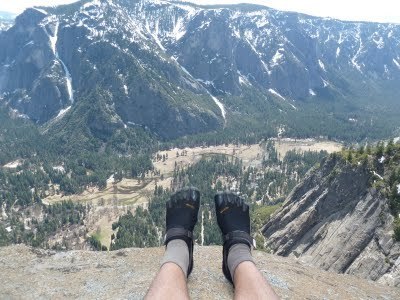
Get updates as soon as they're posted! Click here to subscribe to Running and Rambling.
Check out the Running Life book for a collection of our most popular columns.

The main story next week will be how our family spent two days hiking some of Yosemite National Park's signature trails, in conditions that would be called adventurous even by ultrarunner standards. The side story is that I did both hikes in Vibrams – just as I've done for all of my hiking over the past year and a half – and about all of the comments, inquiries, and occasional snickering that I received along the way.
 Freak feet!
Freak feet! I've mentioned a few times that minimalist footwear is becoming a bit more commonplace in the ultrarunning community, to the point where you're not automatically considered an idiot or a freak for showing up to run 50 miles in a pair of moccasins or barefoot shoes. However, among hikers, there's definitely still a strong element of surprise and disbelief. If I had a nickel for every time I heard something like Did you see what that guy was wearing? or Oh my gosh, that guy was in toe shoes! or even some kind of smart aleck remark after I passed somebody going the opposite direction, I would have finished the hike noticeably wealthier than when I started.
I'm pleased to note that several other people didn't just make comments in passing, but actually stopped to ask me direct questions about the Vibrams - and since I ended up answering a lot of the same inquiries multiple times, I thought that a public debriefing would be useful to anyone who might come across another minimalist idiot in Yosemite someday. Because chances are, that idiot might very well be me.
So here's what I heard most frequently on the trail over the two days of hiking …
Q: Do those give you enough support?
A: This was probably the most common question I received, and it's quite clear that conventional wisdom about having a sturdy footbed and firm structure around the ankle is alive and well among recreational hikers. Of course, the proper answer is no, they don't give me any support … but that's the whole point. Unfortunately, passing someone on the trail doesn't really afford you enough time to have a whole discussion about the inherently brilliant natural architecture of the foot, so I typically summarized this point by saying "I just let the foot do the work". Which I'm sure didn't make any sense to half of the people I told, but you never know.
Q: Don't you need any cushioning?
A: If question #1 was about support, #1A was about cushioning. To be sure, Yosemite's classic trails have a huge amount of granite, often irregularly shaped and jagged, which to many hikers means you need a thick, soft midsole to absorb the impact.
 There's a trail there somewhere
There's a trail there somewhere My answer for this was similar as the first one – I let my foot do the work – with one caveat: I do tend to "pick my line" a bit more carefully when I'm descending the steep, rocky trails than I used to in standard trail shoes. It's very similar to the accommodation I make while trail running, where I take the steep downhills noticeably slower than my previous "bombs away" fashion – but it's not as big of a difference as you might expect. I still jump down onto rocks, or bound from one jagged granite step onto another … but there's just an extra dose of caution thrown in there for good measure – which, considering that I was hiking with my kids instead of racing to get a belt buckle, is probably a good thing.
Q: Do your feet get wet?
A: Yes, definitely. Depending on the conditions, this is the one legitimate drawback to wearing Vibrams on the trail; if air temperatures are decently warm, it's not a big deal, but if it's cold outside (or if the ground is cold – see below), your toes definitely get chilled far more easily than in standard footwear. The flip side of this is that if you're doing full immersions at stream crossings, the Vibrams dry much more quickly than traditional shoes – and at Yosemite in the springtime, crossing runoff channels just goes with the territory.
 Hard to see ... but there's a stream running straight down the trail
Hard to see ... but there's a stream running straight down the trail The only time when I had an issue with comfort was during a stretch of about 45 minutes of continuous snow; between my feet being soaked and the frigid ground sucking heat away from me, my toes got a little bit painful. Luckily, the only remedy I needed was to sit on a warm rock every now and then and let the sun shine on my black-clad toes for a while, and I was fine. But if there hadn't been rocks to sit on every so often, I would have been fairly bummed.
 Warming my toes in the sun
Warming my toes in the sun Q: How is the traction?
A: Pretty much the same as regular shoes, but for this trip, I decided to be a little extra cautious and chose my newer pair of Trek Sports rather than my traditional standby KSO Treks, because the outsole lugs were a little more worn down on the older Treks. Between the knobby outsole and the ability of your foot to grip the ground naturally, traction has almost been a non-factor for me in Vibrams, with a couple of exceptions.
 Thick mist + slick rocks + steep steps = a challenge coming back down
Thick mist + slick rocks + steep steps = a challenge coming back down On steep descents, if the rocky surfaces are both irregular and wet, I have to be even more careful about where I'm placing my feet. If the steep descent has a lot of loose gravel, I have some occasional slipping, but I'd say it's about equivalent to the troubles I see other people having in their super-lugged SUV boots. So I wouldn't say they're slip-proof, but they're probably the equivalent of most standard trail shoes or boots out there.
Q: Don't your feet hurt?
A: The short answer is no, but I'm always careful to include something like "it takes some getting used to" or "I've been doing this for a while". Over the course of a couple of years, I'm now at the point where spending all day on my almost-bare feet on rocky trails isn't that big of a deal, but if you're a newbie minimalist and try to hike up and down some crazy rugged trails, you'll definitely get sore feet afterward. Last year, I did the Mist Trail hike in Vibrams; it was one of the first day hikes I had done in them, and I do remember having significant soreness afterward. This year, I did the same route with no problems at all. So there's obviously an adaptation curve to all this, and I don't want to mislead anyone into thinking that you just slap on a pair of Vibrams and everything's suddenly a breeze.
Q: Why do you wear those?
A: Because it's fun! Actually, check that – it's magnified fun. The same pleasure that I feel in connecting with the earth during routine runs on my home trails of Monterey County is increased about 100-fold when I'm in one of the most majestic places on the planet. Part of the joy I take in being in wilderness areas is the way I feel at one with the landscape – and when I can feel every bump, pebble, and contour of that landscape as I'm moving across it, I feel even more connected than I ever imagined.
 Overlooking the Silver Apron above Vernal Fall
Overlooking the Silver Apron above Vernal Fall Among all of the minimalist shoes I've tested, nothing matches Vibrams in their replicating a true barefoot feel, as if they are a natural extension of the foot – and that's why they're my shoe of choice for long days of hiking. And if there was some way for me to put into words the exhilarating feeling of swinging your nearly-naked feet over the precipice of a cliff or the lip of a high waterfall, I think folks would be lined up at the door wanting to experience it for themselves.
Having said all that, however, wearing the Vibrams wasn't even the highlight of the trip … but for the rest of the story, you'll have to wait until next week.

Get updates as soon as they're posted! Click here to subscribe to Running and Rambling.
Check out the Running Life book for a collection of our most popular columns.

Published on April 21, 2011 21:27
April 20, 2011
Vibrams Over Yosemite
Not much point to today's post, really ... except to share one of many pictures from our family's week at Yosemite National Park:

My Vibram Trek Sports, as seen from the top of Yosemite Falls. I'll have a more specific post about hiking around Yosemite in Vibrams tomorrow night, and another post next week about how the whole family fared on some of Yosemite's most famous and challenging trails (spoiler alert: they did awesome) - but for tonight, I'm just savoring a wonderful trip to one of the most beautiful places on earth.
*
One final note: you've only got two more days to enter my Merrell Barefoot Trail Glove giveaway contest; the winner will be announced this Saturday.
Get updates as soon as they're posted! Click here to subscribe to Running and Rambling.
Check out the Running Life book for a collection of our most popular columns.


My Vibram Trek Sports, as seen from the top of Yosemite Falls. I'll have a more specific post about hiking around Yosemite in Vibrams tomorrow night, and another post next week about how the whole family fared on some of Yosemite's most famous and challenging trails (spoiler alert: they did awesome) - but for tonight, I'm just savoring a wonderful trip to one of the most beautiful places on earth.
*
One final note: you've only got two more days to enter my Merrell Barefoot Trail Glove giveaway contest; the winner will be announced this Saturday.
Get updates as soon as they're posted! Click here to subscribe to Running and Rambling.
Check out the Running Life book for a collection of our most popular columns.

Published on April 20, 2011 20:18
April 19, 2011
Spring Sock Review: SOLE Lightweight and Dual-Layer, Feetures Ultra Light and Elite
I'm not sure how the idea came to me, or why I actually acted on it rather than having the good sense to leave it the heck alone … but a couple of months ago, it occurred to me that perhaps my wife didn't have quite enough things to do. And since I'm a devoted (if somewhat oblivious) husband, and tend to have plenty of gear at my disposal, I figured it would be a great idea to deputize her as a product reviewing apprentice. Honestly, it seemed like a decent thought at the time.
To her credit, she took my foolish notion in stride, and instead of wringing my neck for putting one more crazy task on her plate, she graciously played along. The results of her cooperation will be evident in the next couple of weeks; I've already indicated that she's testing Merrell's Pace Glove for me, and today, I get to report on six different socks from two different companies that she's been testing over the past several weeks.
The sock review seemed like a perfect match for her, because 1) all of the products here are primarily road socks, and she does a lot more road running than I do, and 2) I'm already on record countless times saying that when it comes to socks, my heart belongs to Drymax. So instead of conducting a contest where everyone would be competing for second place, I handed it over to an impartial judge; it seemed like the fair thing to do.
First up were two pairs from SOLE, a company I first profiled when reviewing their sport flips (which, coincidentally, my wife also tested for me; I'm thinking I might need to offer her some sort of benefit plan soon). She tested the dual layer performance sock, a running-specific model, and the lightweight multi-sport sock. Both are extremely thin socks that use Tactel, a synthetic nylon fabric that is very soft, dries eight times faster than cotton, and retains its shape after repeated use and wash cycles. They both also come in multiple heights, are available in either black or white, have seamless toe construction, and employ SOLE's TensorFit arch band to reduce slippage and keep the sock in place.
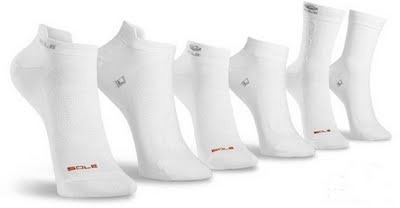 SOLE lightweight sport sock
SOLE lightweight sport sock
The lightweight sport sock has instep vents for increased breathability, with a two-component fabric blend of 82% Tactel and 18% Lycra. The dual layer sock has (as the name implies) two separate layers of fabric to reduce friction and prevent blisters – an inner layer that hugs your foot, and an outer panel with large vents for breathability. If you like dual-layer socks but don't like their thickness, the SOLE sock is for you; it's definitely one of the thinnest dual layer socks I've ever seen. It has a coolmax component to help move moisture away from the foot, with a fabric breakdown of 52% Tactel, 35% Coolmax, and 13% Lycra.
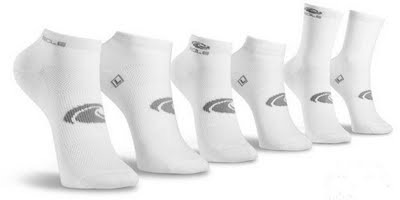 SOLE dual-layer running socks
SOLE dual-layer running socks
As you'd guess from the fabric construction, the lightweight sock is a bit thinner and stretchier, and the dual layer is a bit better at moisture management and blister prevention. As to how they feel, I think it's best to say that one of the hallmarks of a good sock is when it doesn't bother you in any way – in other words, my wife didn't have any complaints about them, but they didn't completely, um … knock her socks off, I guess. They're probably worth a try if you live in a hot climate or like extremely thin socks for running or other athletic activities.
The remainder of the socks were from Feetures (typically written with an exclamation point! To get you excited!), a North Carolina-based family company who suckered me into agreeing to a review by exploiting my affection for the UNC Tar Heels (where I went to grad school). However, I had enough presence of mind to refrain from telling them that my wife went to Duke, because that could have made the whole situation way too awkward. (Yes, these details matter - just ask anyone in North Carolina). She ended up testing three somewhat similar models – the ultra light running, ultra light multi-sport, and light cushioned multi-sport – as well as the Elite, a new model which turned out to be the real standout of the group.
Differences between the first three socks are fairly subtle: the light cushioned socks are slightly thicker than the ultra light versions, the ultra light running has a Durasoft fabric blend of merino wool and bamboo rayon for softness, moisture wicking, and odor control, while the multi-sport models have a trendy-sounding iWick fabric for moisture transfer. They're all made with SnugFit technology which uses bands of Lycra to hug the foot, Y-heel construction which prevents the sock from slipping in to the shoe, and a seamless toe area.
 Feetures ultra light running sock
Feetures ultra light running sock
Aside from the cushioned versions feeling thicker than the ultra lights, my wife had a hard time distinguishing any performance difference between these three – but again, she didn't really have anything negative to say. They all feel smooth against the foot, are good at not bunching inside the shoe, and seem well-built with no stray elastic or loose threads after multiple washings.
However, she did notice a clear difference with the feel and function of the Elite, Feetures's new ultra light running and cycling sock. It's tangibly thinner and lighter than the other models, and fits even more securely. Fabric construction is 79% iWick, 13% polyester, 13% Lycra/Spandex, and each pair has a designated left and right sock, anatomically contoured specifically to that particular foot. There's also a Power Arch design which provides additional support to the instep area. This is an aspect that particularly impressed my wife, in that she's been having some increased arch pain recently - perhaps related to the aforementioned barefoot shoes she's been testing for me, but that's another story – and she can feel the difference in support when wearing the Elite socks compared to any of the others.
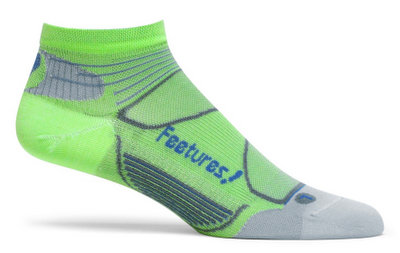 Feetures Elite sock
Feetures Elite sock
So if there's a clear winner from this comparison review, it's the Elite sock from Feetures. There's not really a clunker in the whole bunch, though – so if you're feeling adventurous and want to try out a sampler of socks, here are your links to purchase pages from the company websites:
SOLE lightweight sport sock: $9.50 - $12.50 depending on ankle height
SOLE dual-layer performance sock: $12.50 - $15.00 depending on ankle height
Feetures ultra light running sock:$13.99
Feetures ultra light multi-sport sock: $13.99
Feetures light cushioned multi-sport: $10.99
Feetures Elite ultra light running/cycling sock: $13.99
*Products provided by SOLE and Feetures
**See other product reviews on sidebar at right. If you have a product you'd like reviewed, contact me at info@runningandrambling.com.
Get updates as soon as they're posted! Click here to subscribe to Running and Rambling.
Check out the Running Life book for a collection of our most popular columns.

To her credit, she took my foolish notion in stride, and instead of wringing my neck for putting one more crazy task on her plate, she graciously played along. The results of her cooperation will be evident in the next couple of weeks; I've already indicated that she's testing Merrell's Pace Glove for me, and today, I get to report on six different socks from two different companies that she's been testing over the past several weeks.
The sock review seemed like a perfect match for her, because 1) all of the products here are primarily road socks, and she does a lot more road running than I do, and 2) I'm already on record countless times saying that when it comes to socks, my heart belongs to Drymax. So instead of conducting a contest where everyone would be competing for second place, I handed it over to an impartial judge; it seemed like the fair thing to do.
First up were two pairs from SOLE, a company I first profiled when reviewing their sport flips (which, coincidentally, my wife also tested for me; I'm thinking I might need to offer her some sort of benefit plan soon). She tested the dual layer performance sock, a running-specific model, and the lightweight multi-sport sock. Both are extremely thin socks that use Tactel, a synthetic nylon fabric that is very soft, dries eight times faster than cotton, and retains its shape after repeated use and wash cycles. They both also come in multiple heights, are available in either black or white, have seamless toe construction, and employ SOLE's TensorFit arch band to reduce slippage and keep the sock in place.
 SOLE lightweight sport sock
SOLE lightweight sport sockThe lightweight sport sock has instep vents for increased breathability, with a two-component fabric blend of 82% Tactel and 18% Lycra. The dual layer sock has (as the name implies) two separate layers of fabric to reduce friction and prevent blisters – an inner layer that hugs your foot, and an outer panel with large vents for breathability. If you like dual-layer socks but don't like their thickness, the SOLE sock is for you; it's definitely one of the thinnest dual layer socks I've ever seen. It has a coolmax component to help move moisture away from the foot, with a fabric breakdown of 52% Tactel, 35% Coolmax, and 13% Lycra.
 SOLE dual-layer running socks
SOLE dual-layer running socksAs you'd guess from the fabric construction, the lightweight sock is a bit thinner and stretchier, and the dual layer is a bit better at moisture management and blister prevention. As to how they feel, I think it's best to say that one of the hallmarks of a good sock is when it doesn't bother you in any way – in other words, my wife didn't have any complaints about them, but they didn't completely, um … knock her socks off, I guess. They're probably worth a try if you live in a hot climate or like extremely thin socks for running or other athletic activities.
The remainder of the socks were from Feetures (typically written with an exclamation point! To get you excited!), a North Carolina-based family company who suckered me into agreeing to a review by exploiting my affection for the UNC Tar Heels (where I went to grad school). However, I had enough presence of mind to refrain from telling them that my wife went to Duke, because that could have made the whole situation way too awkward. (Yes, these details matter - just ask anyone in North Carolina). She ended up testing three somewhat similar models – the ultra light running, ultra light multi-sport, and light cushioned multi-sport – as well as the Elite, a new model which turned out to be the real standout of the group.
Differences between the first three socks are fairly subtle: the light cushioned socks are slightly thicker than the ultra light versions, the ultra light running has a Durasoft fabric blend of merino wool and bamboo rayon for softness, moisture wicking, and odor control, while the multi-sport models have a trendy-sounding iWick fabric for moisture transfer. They're all made with SnugFit technology which uses bands of Lycra to hug the foot, Y-heel construction which prevents the sock from slipping in to the shoe, and a seamless toe area.
 Feetures ultra light running sock
Feetures ultra light running sockAside from the cushioned versions feeling thicker than the ultra lights, my wife had a hard time distinguishing any performance difference between these three – but again, she didn't really have anything negative to say. They all feel smooth against the foot, are good at not bunching inside the shoe, and seem well-built with no stray elastic or loose threads after multiple washings.
However, she did notice a clear difference with the feel and function of the Elite, Feetures's new ultra light running and cycling sock. It's tangibly thinner and lighter than the other models, and fits even more securely. Fabric construction is 79% iWick, 13% polyester, 13% Lycra/Spandex, and each pair has a designated left and right sock, anatomically contoured specifically to that particular foot. There's also a Power Arch design which provides additional support to the instep area. This is an aspect that particularly impressed my wife, in that she's been having some increased arch pain recently - perhaps related to the aforementioned barefoot shoes she's been testing for me, but that's another story – and she can feel the difference in support when wearing the Elite socks compared to any of the others.
 Feetures Elite sock
Feetures Elite sockSo if there's a clear winner from this comparison review, it's the Elite sock from Feetures. There's not really a clunker in the whole bunch, though – so if you're feeling adventurous and want to try out a sampler of socks, here are your links to purchase pages from the company websites:
SOLE lightweight sport sock: $9.50 - $12.50 depending on ankle height
SOLE dual-layer performance sock: $12.50 - $15.00 depending on ankle height
Feetures ultra light running sock:$13.99
Feetures ultra light multi-sport sock: $13.99
Feetures light cushioned multi-sport: $10.99
Feetures Elite ultra light running/cycling sock: $13.99
*Products provided by SOLE and Feetures
**See other product reviews on sidebar at right. If you have a product you'd like reviewed, contact me at info@runningandrambling.com.
Get updates as soon as they're posted! Click here to subscribe to Running and Rambling.
Check out the Running Life book for a collection of our most popular columns.

Published on April 19, 2011 13:58
April 17, 2011
Other Than Me
"I am who I am, who I am, well who am I –
Requesting some enlightenment –
Could I have been anyone other than me?"
- Dave Matthews Band, "Dancing Nancies" (video after post)
What if I told you that this was your house:
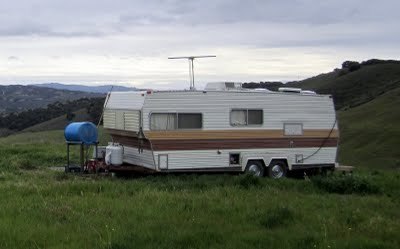
Would that be someplace you'd be happy with? A place where you'd feel good about where life has taken you? Wait just a couple minutes before you answer - because the proposition is a bit more complicated than that.
So you live in a trailer; that's not exactly fantastic news. The good part is you can park it wherever you like – even on a hilltop in the middle of a beautiful open space:
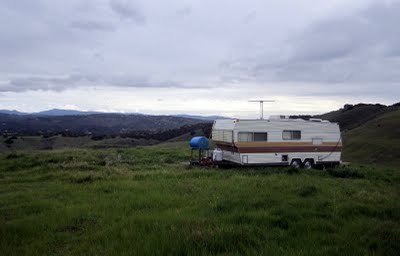
With some wonderful views of the valley below:
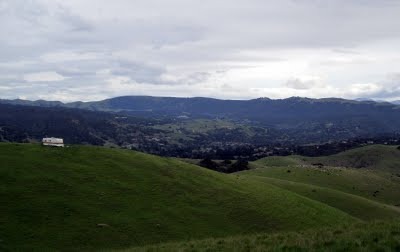
And spectacular morning sunrises:

Does that make the situation a little more appealing now?
And what if I told you that you could work from home, so you don't have to deal with the hassle of a daily commute? There aren't any corporate politics to frustrate you, and you generally get to make your own hours, as long as you're available to your employees when they need you.
Yes, you have employees, and you're the boss. Your role is actually quite important, as you're responsible for the well-being of a few hundred direct reports:

Although they're generally well-behaved, they tend to have some difficulty identifying with the larger goals of the organization, so they typically need a lot of guidance and supervision:
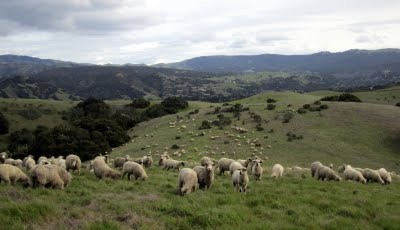
Fortunately, you've got a few middle managers who are very effective motivators, and can usually be relied upon to direct the front-line staff in working toward a common purpose:
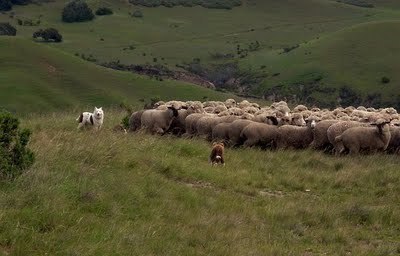
You still have to stay on top of things, however – because every now and then, one of your middle managers might feel like slacking in the shade for a while:

And you're ultimately the person responsible for making sure that everything gets done.
Sometimes in the midst of an early morning run, I contemplate what life as a modern-day shepherd would be like, especially in the unique case of the guy who's charged with overseeing the Fort Ord open space. I mean … yes, you'd live in a trailer, but the pace of life is blissfully slow. You'd get to spend day after day in one of the most scenic places imaginable, sleeping and waking with the sun, living a life of simplicity rather than battling the complexities and frustrations of the modern world. Sure, it's hard to buy groceries or go out to the movies, but in my book there's a lot to be said for the beauty of solitude.
(Besides, it's not like you'd be totally isolated from society: you can shop on the Internet, watch TV online or movies from Netflix, and maintain a vast network of friends via social media. In fact, it's a good bet this dude has his own Facebook page – and part of me wants to scan Twitter for names like @FortOrdTrailer or @MontereyShepherd to see what I find. On second thought, I probably won't; it would be too discouraging to learn that he has more friends or followers than me.)
I've seen the shepherd several times in the midst of a my trail runs or bike rides, but never said anything more than "hi" or "good morning" as we're both performing our selected tasks. The easy solution to my questions, of course, would be to just stop and pick his brain for a few minutes about job satisfaction and quality of life … but somehow I think if I actually found out, that would diminish my experience the next time I wander by.
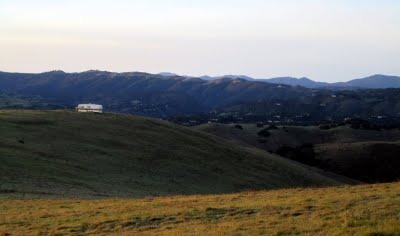 Because half of the fun is in the wondering: whether I could live a life that's so foreign to my own, whether I could be happy in a completely different set of circumstances, whether I could be anyone other than me. I suppose no one can ever know these things for sure, but they're definitely interesting notions to think about when I'm making my early morning rounds.
Because half of the fun is in the wondering: whether I could live a life that's so foreign to my own, whether I could be happy in a completely different set of circumstances, whether I could be anyone other than me. I suppose no one can ever know these things for sure, but they're definitely interesting notions to think about when I'm making my early morning rounds.
*
I always waffle back and forth about whether I prefer DMB's music played with the full band, or in the more chilled-out acoustic settings he specializes in. More often than not, the decision is based on my mood - and today, you're getting acoustic. Either way, this one's a gem.
Dave Matthews, "Dancing Nancies" (click to play; the song gets started about 1 minute in):
Get updates as soon as they're posted! Click here to subscribe to Running and Rambling.
Check out the Running Life book for a collection of our most popular columns.

Requesting some enlightenment –
Could I have been anyone other than me?"
- Dave Matthews Band, "Dancing Nancies" (video after post)
What if I told you that this was your house:

Would that be someplace you'd be happy with? A place where you'd feel good about where life has taken you? Wait just a couple minutes before you answer - because the proposition is a bit more complicated than that.
So you live in a trailer; that's not exactly fantastic news. The good part is you can park it wherever you like – even on a hilltop in the middle of a beautiful open space:

With some wonderful views of the valley below:

And spectacular morning sunrises:

Does that make the situation a little more appealing now?
And what if I told you that you could work from home, so you don't have to deal with the hassle of a daily commute? There aren't any corporate politics to frustrate you, and you generally get to make your own hours, as long as you're available to your employees when they need you.
Yes, you have employees, and you're the boss. Your role is actually quite important, as you're responsible for the well-being of a few hundred direct reports:

Although they're generally well-behaved, they tend to have some difficulty identifying with the larger goals of the organization, so they typically need a lot of guidance and supervision:

Fortunately, you've got a few middle managers who are very effective motivators, and can usually be relied upon to direct the front-line staff in working toward a common purpose:

You still have to stay on top of things, however – because every now and then, one of your middle managers might feel like slacking in the shade for a while:

And you're ultimately the person responsible for making sure that everything gets done.
Sometimes in the midst of an early morning run, I contemplate what life as a modern-day shepherd would be like, especially in the unique case of the guy who's charged with overseeing the Fort Ord open space. I mean … yes, you'd live in a trailer, but the pace of life is blissfully slow. You'd get to spend day after day in one of the most scenic places imaginable, sleeping and waking with the sun, living a life of simplicity rather than battling the complexities and frustrations of the modern world. Sure, it's hard to buy groceries or go out to the movies, but in my book there's a lot to be said for the beauty of solitude.
(Besides, it's not like you'd be totally isolated from society: you can shop on the Internet, watch TV online or movies from Netflix, and maintain a vast network of friends via social media. In fact, it's a good bet this dude has his own Facebook page – and part of me wants to scan Twitter for names like @FortOrdTrailer or @MontereyShepherd to see what I find. On second thought, I probably won't; it would be too discouraging to learn that he has more friends or followers than me.)
I've seen the shepherd several times in the midst of a my trail runs or bike rides, but never said anything more than "hi" or "good morning" as we're both performing our selected tasks. The easy solution to my questions, of course, would be to just stop and pick his brain for a few minutes about job satisfaction and quality of life … but somehow I think if I actually found out, that would diminish my experience the next time I wander by.
 Because half of the fun is in the wondering: whether I could live a life that's so foreign to my own, whether I could be happy in a completely different set of circumstances, whether I could be anyone other than me. I suppose no one can ever know these things for sure, but they're definitely interesting notions to think about when I'm making my early morning rounds.
Because half of the fun is in the wondering: whether I could live a life that's so foreign to my own, whether I could be happy in a completely different set of circumstances, whether I could be anyone other than me. I suppose no one can ever know these things for sure, but they're definitely interesting notions to think about when I'm making my early morning rounds.*
I always waffle back and forth about whether I prefer DMB's music played with the full band, or in the more chilled-out acoustic settings he specializes in. More often than not, the decision is based on my mood - and today, you're getting acoustic. Either way, this one's a gem.
Dave Matthews, "Dancing Nancies" (click to play; the song gets started about 1 minute in):
Get updates as soon as they're posted! Click here to subscribe to Running and Rambling.
Check out the Running Life book for a collection of our most popular columns.

Published on April 17, 2011 17:40
April 16, 2011
Random Shots of Beauty (Bonus Edition!)
One reminder before our regularly scheduled programming: if you somehow missed it earlier in the week, be sure to check out my Merrell Barefoot Trail Glove review, and enter for your chance to win a free pair.
*
This weekend's RSOB comes from very familiar territory:
 Sunrise over Fort Ord, in the early miles of a long midweek training run. These are the kind of scenes that are worth waking up early for.
Sunrise over Fort Ord, in the early miles of a long midweek training run. These are the kind of scenes that are worth waking up early for.
But wait - that's not all! This weekend you're getting some bonus Random Shots of Beauty, courtesy of my two daughters and their elementary school art show that took place this week. The first one is from my 1st grader, who is enamored with sea otters and wants to become a marine biologist someday:
 It's called An Otter in the Ocean; simple, straightforward, and pretty much what we'd expect from her.
It's called An Otter in the Ocean; simple, straightforward, and pretty much what we'd expect from her.
Her older sister had similar aquatic theme:
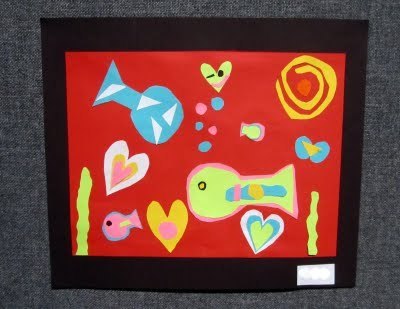 Asked for the title, she replied, "Um ... it doesn't really have a name." So we'll just agree to call it Untitled.
Asked for the title, she replied, "Um ... it doesn't really have a name." So we'll just agree to call it Untitled.
*
One last administrative note: I'm off to Yosemite for a few days, and hoping to have a couple of posts robo-published here in my absence - but if for some reason there are technical difficulties, please stand by until we get officially rolling again at the end of the week.
Get updates as soon as they're posted! Click here to subscribe to Running and Rambling.
Check out the Running Life book for a collection of our most popular columns.

*
This weekend's RSOB comes from very familiar territory:
 Sunrise over Fort Ord, in the early miles of a long midweek training run. These are the kind of scenes that are worth waking up early for.
Sunrise over Fort Ord, in the early miles of a long midweek training run. These are the kind of scenes that are worth waking up early for.But wait - that's not all! This weekend you're getting some bonus Random Shots of Beauty, courtesy of my two daughters and their elementary school art show that took place this week. The first one is from my 1st grader, who is enamored with sea otters and wants to become a marine biologist someday:
 It's called An Otter in the Ocean; simple, straightforward, and pretty much what we'd expect from her.
It's called An Otter in the Ocean; simple, straightforward, and pretty much what we'd expect from her.Her older sister had similar aquatic theme:
 Asked for the title, she replied, "Um ... it doesn't really have a name." So we'll just agree to call it Untitled.
Asked for the title, she replied, "Um ... it doesn't really have a name." So we'll just agree to call it Untitled.*
One last administrative note: I'm off to Yosemite for a few days, and hoping to have a couple of posts robo-published here in my absence - but if for some reason there are technical difficulties, please stand by until we get officially rolling again at the end of the week.
Get updates as soon as they're posted! Click here to subscribe to Running and Rambling.
Check out the Running Life book for a collection of our most popular columns.

Published on April 16, 2011 09:47
April 14, 2011
Big Sur Marathon Out and Back Course; Running Life Book Discount
Around the Monterey Peninsula, as well as some regions of the Internet, it's fairly common knowledge that my friend Mike and I write a running column for our local newspaper. And most people in these parts have at least a passing awareness that the Big Sur Marathon is right around the corner.
So when one of the major news stories in our community was the landslide that took out a section of Highway 1 – along with a sizeable chunk of the Big Sur Marathon course – last month, more than a few people wondered when we would write something about it for the newspaper. Obviously, the story was right up our alley, but we wanted to present a somewhat different angle than "Gee, this kinda sucks."
Fortunately, we had some experience to draw upon: a similar situation 13 years ago, the only other time that the Big Sur Marathon course was changed, and a race in which Mike and I both happened to participate. We realized that our memories from that year weren't particularly better or worse than other times we've run the race, and we decided to look for some objective comparisons that might draw similar conclusions. The result is the article that follows below: an analysis of the one previous "out and back" year compared to others, and a reassurance that this year's participants will still have a great experience at our hometown race.
Before the article, one more note related to this year's Big Sur Marathon: Mike and I will be at the race expo, signing copies of our book and selling them at a 20% discount. We decided to extend the discount offer to online customers as well – so between now and race day on May 1st, you can get a copy of our Running Life book at a reduced price from our website. Click here to go to our webpage, and remember to include instructions to us if you want signed copies or any other individual touches.
 Or you can just click the photo ...
Or you can just click the photo ...
Running Life 4/7/11 "Out and Back"
As virtually everyone knows by now, a sizeable piece of Highway 1 is currently sitting in the Pacific Ocean. To runners, Highway 1 is better known as the Big Sur Marathon course – so when the announcement was made that the world-famous course would be altered, some portions of the running community went into a bit of a tizzy.
Take it from us: don't worry about the Big Sur International Marathon. Everything will be fine.
First, let's clarify something from a practical standpoint: there's absolutely no way that the regular course could be used this year. Even if a makeshift road is in place by race day – an uncertain bet thanks to weather complications and inevitable construction delays – the road can't possibly handle the nearly 200 buses that travel back and forth on race morning. Concern for runner safety has to be the top priority, and the race board made the right decision in changing the course for this year's event on May 1st.
A similar natural disaster caused a re-routing in 1998, which marathon veterans lovingly call the "out and back" year. If you're superstitious, it's interesting to note that 1998 was the 13th presentation of the Big Sur Marathon and this year is the 26th. 1998 was also the first year Wally Kastner was Race Director and Dr. Hugo Ferlito was Chairman of the Board, presenting them with a significant trial by fire. Ferlito stepped down last year, but Kastner is still the RD, so the reroute isn't uncharted territory for him.
We checked statistics from the out and back 1998 race and the regular course in 1999, which both enjoyed nearly perfect weather. The average men's finishing time in 1998 was 4:08 and in 1999 was 4:09. The average woman's finishing time was 4:27 in 1998 and 4:26 in 1999. It's likely that the supposed "advantage" of not climbing the 2-mile grind up to Hurricane Point is compensated by running through the steeply rolling hills of Carmel Highlands twice. Course times were so similar that the men's winner in 1998, Srba Nikolic, ran 2:21:36 and the following year ran 2:21:37 while finishing third behind winner Arsenio Ortiz's 2:19:16.
The big difference in logistics is that in 1998 the course repairs were on Hurricane Point, south of Bixby Bridge, which allowed a full 13.1 miles of road from Carmel before the turnaround point. This year's damage is north of Bixby, requiring an additional 1.75-mile detour through Point Lobos on the way back up the coast. This year's runners will be the first ever to race through the breathtaking coastline of Point Lobos, which could provide a much-needed pick-me-up between miles 22 and 24.
Another difference from 1998 is what we'll call the Facebook effect, which has proven to be something of a mixed blessing. When the course change was announced, runners took to posting hundreds of comments on the BSIM Facebook page. Some of the initial commenters were out of town participants who questioned whether the road was really unrunnable, or whether the race should offer refunds because runners couldn't experience the Big Sur coastline or Hurricane Point. The anger and rudeness of some of them made us cringe, but each one was replied to professionally by the BSIM staff.
Fortunately, the majority of comments were sympathetic, encouraging, and upbeat, and it's been great to see how most of the running community has resolved to make the best of a difficult situation and embrace this year's race for the unique challenge it offers. We can assure them that nearly every aspect of the race will be as fantastic as they usually are.
Good luck to all the participants of this year's Big Sur International Marathon; your accomplishment will still be just as significant, your feeling of satisfaction just as rewarding, and your experience just as beautiful as any other in the history of this wonderful race.
Get updates as soon as they're posted! Click here to subscribe to Running and Rambling.
Check out the Running Life book for a collection of our most popular columns.

So when one of the major news stories in our community was the landslide that took out a section of Highway 1 – along with a sizeable chunk of the Big Sur Marathon course – last month, more than a few people wondered when we would write something about it for the newspaper. Obviously, the story was right up our alley, but we wanted to present a somewhat different angle than "Gee, this kinda sucks."
Fortunately, we had some experience to draw upon: a similar situation 13 years ago, the only other time that the Big Sur Marathon course was changed, and a race in which Mike and I both happened to participate. We realized that our memories from that year weren't particularly better or worse than other times we've run the race, and we decided to look for some objective comparisons that might draw similar conclusions. The result is the article that follows below: an analysis of the one previous "out and back" year compared to others, and a reassurance that this year's participants will still have a great experience at our hometown race.
Before the article, one more note related to this year's Big Sur Marathon: Mike and I will be at the race expo, signing copies of our book and selling them at a 20% discount. We decided to extend the discount offer to online customers as well – so between now and race day on May 1st, you can get a copy of our Running Life book at a reduced price from our website. Click here to go to our webpage, and remember to include instructions to us if you want signed copies or any other individual touches.
 Or you can just click the photo ...
Or you can just click the photo ...Running Life 4/7/11 "Out and Back"
As virtually everyone knows by now, a sizeable piece of Highway 1 is currently sitting in the Pacific Ocean. To runners, Highway 1 is better known as the Big Sur Marathon course – so when the announcement was made that the world-famous course would be altered, some portions of the running community went into a bit of a tizzy.
Take it from us: don't worry about the Big Sur International Marathon. Everything will be fine.
First, let's clarify something from a practical standpoint: there's absolutely no way that the regular course could be used this year. Even if a makeshift road is in place by race day – an uncertain bet thanks to weather complications and inevitable construction delays – the road can't possibly handle the nearly 200 buses that travel back and forth on race morning. Concern for runner safety has to be the top priority, and the race board made the right decision in changing the course for this year's event on May 1st.
A similar natural disaster caused a re-routing in 1998, which marathon veterans lovingly call the "out and back" year. If you're superstitious, it's interesting to note that 1998 was the 13th presentation of the Big Sur Marathon and this year is the 26th. 1998 was also the first year Wally Kastner was Race Director and Dr. Hugo Ferlito was Chairman of the Board, presenting them with a significant trial by fire. Ferlito stepped down last year, but Kastner is still the RD, so the reroute isn't uncharted territory for him.
We checked statistics from the out and back 1998 race and the regular course in 1999, which both enjoyed nearly perfect weather. The average men's finishing time in 1998 was 4:08 and in 1999 was 4:09. The average woman's finishing time was 4:27 in 1998 and 4:26 in 1999. It's likely that the supposed "advantage" of not climbing the 2-mile grind up to Hurricane Point is compensated by running through the steeply rolling hills of Carmel Highlands twice. Course times were so similar that the men's winner in 1998, Srba Nikolic, ran 2:21:36 and the following year ran 2:21:37 while finishing third behind winner Arsenio Ortiz's 2:19:16.
The big difference in logistics is that in 1998 the course repairs were on Hurricane Point, south of Bixby Bridge, which allowed a full 13.1 miles of road from Carmel before the turnaround point. This year's damage is north of Bixby, requiring an additional 1.75-mile detour through Point Lobos on the way back up the coast. This year's runners will be the first ever to race through the breathtaking coastline of Point Lobos, which could provide a much-needed pick-me-up between miles 22 and 24.
Another difference from 1998 is what we'll call the Facebook effect, which has proven to be something of a mixed blessing. When the course change was announced, runners took to posting hundreds of comments on the BSIM Facebook page. Some of the initial commenters were out of town participants who questioned whether the road was really unrunnable, or whether the race should offer refunds because runners couldn't experience the Big Sur coastline or Hurricane Point. The anger and rudeness of some of them made us cringe, but each one was replied to professionally by the BSIM staff.
Fortunately, the majority of comments were sympathetic, encouraging, and upbeat, and it's been great to see how most of the running community has resolved to make the best of a difficult situation and embrace this year's race for the unique challenge it offers. We can assure them that nearly every aspect of the race will be as fantastic as they usually are.
Good luck to all the participants of this year's Big Sur International Marathon; your accomplishment will still be just as significant, your feeling of satisfaction just as rewarding, and your experience just as beautiful as any other in the history of this wonderful race.
Get updates as soon as they're posted! Click here to subscribe to Running and Rambling.
Check out the Running Life book for a collection of our most popular columns.

Published on April 14, 2011 18:27
April 12, 2011
Merrell Barefoot Trail Glove Review and Giveaway
While I firmly believe that minimalist running is here to stay, I also think it will reach a settling point over the long term. I anticipate that many traditional runners will become convinced of the benefits of barefoot biomechanics, but will still want a marginal amount of comfort and protection from their everyday shoes. I also suspect that a percentage of current barefoot and minimalist diehards will eventually drift back – either for reasons of comfort or performance, or both – towards footwear that is something more than a flat slab of rubber and a little bit of leather.
Accordingly, there will be a huge demand for "nearly" barefoot shoes that are structured enough to appeal to wary traditionalists, but minimal enough to attract purists as well; basically, something that can bring minimalism to the mainstream consumer. And when that time comes, Merrell will be ready.
More than any other company this year, Merrell has completely thrown its arms around the barefoot and minimalist movement: from recognizing numerous biomechanics studies detailing the advantages of natural running, to educating its customers (largely through the efforts of barefoot advocate Jason Robillard) in proper barefoot technique, to supporting the minimalist community through a dedicated website and social media campaign, to creating a whole collection of footwear designed to appeal to the widest possible spectrum of folks interested in minimalism. This isn't a "me, too" effort by a major company looking to cash in on the latest trend – it's a genuine investment by an established industry player acknowledging that minimalist footwear is here to stay, and looking to establish itself as the dominant brand in bringing minimalism to the masses.
To my additional delight, they've also proven to be one of the most generous companies I've encountered – which is the perfect cue to announce two upcoming giveaways. After today's review, we'll have a contest for one pair of Merrell's Men's Trail Glove, which will be described shortly. A couple of weeks from now, I'll post a review of their Women's Pace Glove, and give away one pair of those as well. But if you're still not a fan of the company after what I've just described, allow me to introduce you to the Trail Glove, which makes a strong case as one of the best minimalist trail shoes on the market today.
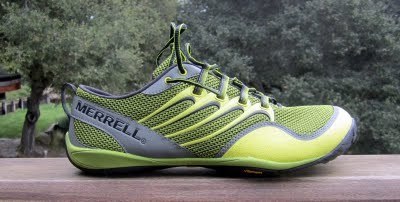 Merrell Barefoot Trail Glove
Merrell Barefoot Trail Glove
As usual, we'll consider the vital specs first: the Trail Glove weighs in at 6.2 oz, with a midsole height of 12mm at both heel and forefoot. Thus, it's a very lightweight zero-drop shoe that places you slightly higher off the ground than a pair of Vibrams (8mm for the KSO Trek), but lower and flatter than New Balance's Minimus Trail (15mm heel/11mm forefoot). It has some protective features of traditional shoes without sacrificing any of the flexibility or mechanics of barefoot running.
 Mesh upper; Omni-fit lacing with straps across tongue; laces also attached to side TPU overlays
Mesh upper; Omni-fit lacing with straps across tongue; laces also attached to side TPU overlays
Material construction of the upper is a somewhat traditional microfiber and air mesh design, with a rubberized bumper at the front for abrasion and impact resistance. Through the midfoot, synthetic overlays are looped into the lacing system, creating a very snug midfoot and forefoot feel. I found the uppers to be extremely effective at draining and drying after water immersions, but still warm enough to keep your toes happy when air temperatures get frosty. The toe box is wide enough to prevent hot spots and to allow your toes to splay without impingement. There's a slight upward curvature to the toebox, but when they're actually on my feet I found this to be unnoticeable.
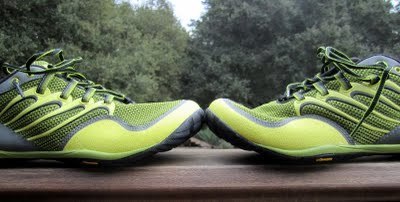 Upward curvature of toebox; yellow TPU overlays
Upward curvature of toebox; yellow TPU overlays
The overall shape of the upper is cut to be snug through the metatarsal area, to the point where it's sometimes hard for me to get my foot into the shoe (more on this in a second). It accomplishes a similar feel as the forefoot of New Balance's Minimus Trail, without having an actual strap across the top of the foot. Merrell's Omni-fit lacing system incorporates not just the TPU overlays on the side of the shoe, but small straps across the tongue as well, so that tension is applied evenly across the entire upper when the laces are tightened.
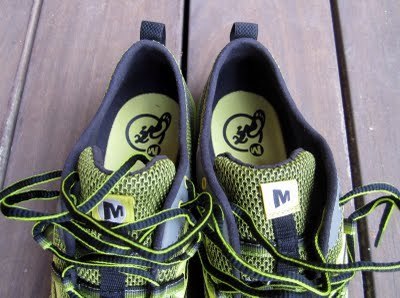 Thin ankle collar
Thin ankle collar
Since the Trail Glove is designed to be worn without socks, its ankle collar is very thin and sits snug around the heel, with an interior sockliner that is quite plush and comfortable against your skin. The antimicrobial microfiber footbed below has a somewhat rubbery feel to it, which further minimizes any slipping of the foot. If you're keeping track, that's about 5 different structural mechanisms to keep your foot stable and secure on top of the midsole, resulting in an overall feel like the shoe is simply an extension of your foot. Whether you're on irregular terrain or steep downhills, your foot isn't going anywhere it shouldn't be inside this shoe.
 Microfiber footbed; soft internal sockliner
Microfiber footbed; soft internal sockliner
One caveat to the whole sockless fit concept is that the upper is almost too snug to wear with traditional trail running socks. I'm not a fan of going sockless, especially on high-mileage days, so I wear socks for most of my longer runs in these shoes – but I find that even when wearing my thinnest socks (Drymax Lite Trail), I have to kind of wriggle my foot into the upper when putting the Trail Gloves on. Once I'm in, I'm good to go … but I've learned to budget for an extra 30 seconds or so when getting dressed in the morning. Fortunately, it's a compromise I can live with.
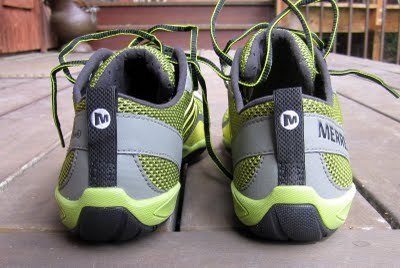 Rear view: stability overlay strap, EVA midsole above rubber outsole
Rear view: stability overlay strap, EVA midsole above rubber outsole
With most natural running shoes, there's a performance tradeoff through the midsole area; true minimalist fans want their footwear to be as flexible as possible, which inherently limits the possibility of incorporating any protective features. And if there's any midsole at all (for purists, none is preferable), it should be as thin as possible to maintain maximal ground feel against the bottom of the foot. This is where Merrell has staked out a nice middle ground, by incorporating two design elements that add a dose of comfort while not detracting too significantly from overall barefoot feel.
The first element isn't anything novel: it's a 4mm compression-molded EVA layer between the outsole and insole. This thickness is similar to Vibram's Trek midsole – and just as with the FiveFingers, I've also noticed that there's a settling period during the first 100 miles or so of use. In other words, the initial "cushy" feeling eventually recedes to allow improved ground feel than you have on your first run out of the box.
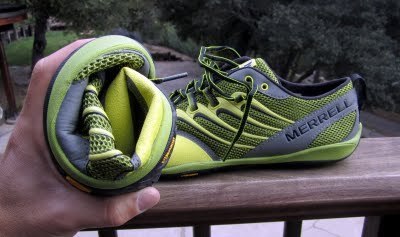 Great flexibility, along with great protection
Great flexibility, along with great protection
It's in the forefoot area that Merrell offers a cool innovation: a 1mm forefoot plate that distributes impact pressure from sharp rocks, but is still completely flexible. This combination of slight cushioning and slight impact protection makes the Trail Glove somewhat unique in the spectrum of minimalist trail shoes. From my testing, its ground feel is slightly less than Vibram's Trek or Terra Plana's Evo, but there's a little more comfort over exceedingly long runs or rugged terrain. Compared to New Balance's Minimus, the Trail Glove has a similar level of comfort, with slightly better ground feel. Granted, we're talking about differences of millimeters one way or the other – but if you're a longtime minimalist runner, you notice these things.
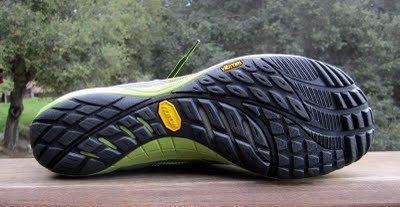 Vibram rubber outsole
Vibram rubber outsole
For the outsole, Merrell turned to the most prominent name in performance footwear. The Trail Glove features Vibram TC-1 rubber that is cut with moderate "knobbing" throughout and ridges across the front end. Like a pair of FiveFingers, it's contoured very closely through the arch area and narrow through the midfoot. Durability of the outsole has been excellent after about 150 miles, and traction has been great in a variety of conditions (with a couple of exceptions below), especially on wet surfaces. I've worn my Trail Gloves for a handful of knee-deep stream crossings, and I was pleasantly surprised at how secure my footing was on the round, slick rocks beneath the surface. They also remain quite stable in mud, and grip nicely around irregular surfaces like rocks and roots.
The only drawback to the outsole I've experienced is some minor slipping on loose gravel on steep hills. Going up, the knobs and ridges don't grab the dirt, occasionally just pushing it backwards a bit. On steep descents, I've had a little bit of sliding on top of the dirt, especially if I've run through some wet conditions already and have some lingering mud caked into the lugs. This particular problem isn't uncommon with other shoes, and I'd rank the Trail Glove outsole slightly ahead of the Vibram Trek or Terra Plana Evo, but slightly behind the New Balance Minimus in this regard.
Overall, Merrell has done an outstanding job of incorporating nearly all the elements of barefoot mechanics while offering a compelling option for traditional runners who are reluctant to go "all the way" to pure minimalist footwear. In an increasingly crowded field, the Trail Glove is a true standout that's equally suited for ultramarathons or light recreational use. It's clear that Merrell did their homework in developing this shoe, which isn't too surprising in light of their extended commitment that I described at the beginning of the post. If their goal is to make minimalism accessible and enjoyable for the masses, the Trail Glove should be considered an enormous success.
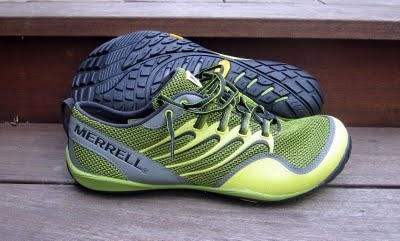
Merrell's Trail Glove retails for $110 from TravelCountry.com as well as other online vendors – but in conjunction with this review, one lucky reader will get a pair for free. My usual "big" contest rules apply here: we'll do a weighted entry system, with additional entries for links to this post from your blog and/or Facebook page (remember, I double-check sometimes). Leave a comment below for a single entry, and let me know how many additional tickets you've earned, for a possibility of up to three total entries. Remember, this is a men's shoe only – so ladies, you're entering for your brothers or husbands on this one (which is fine with me), and your own contest will take place later this month.
The winner will be announced on Saturday, April 23rd. Good luck to everybody, and thanks very much to Merrell for sponsoring such an awesome giveaway!
*Product provided by Merrell **See other product reviews on sidebar at right. If you have a product you'd like reviewed, contact me at info@runningandrambling.com.
Get updates as soon as they're posted! Click here to subscribe to Running and Rambling.
Check out the Running Life book for a collection of our most popular columns.

Accordingly, there will be a huge demand for "nearly" barefoot shoes that are structured enough to appeal to wary traditionalists, but minimal enough to attract purists as well; basically, something that can bring minimalism to the mainstream consumer. And when that time comes, Merrell will be ready.
More than any other company this year, Merrell has completely thrown its arms around the barefoot and minimalist movement: from recognizing numerous biomechanics studies detailing the advantages of natural running, to educating its customers (largely through the efforts of barefoot advocate Jason Robillard) in proper barefoot technique, to supporting the minimalist community through a dedicated website and social media campaign, to creating a whole collection of footwear designed to appeal to the widest possible spectrum of folks interested in minimalism. This isn't a "me, too" effort by a major company looking to cash in on the latest trend – it's a genuine investment by an established industry player acknowledging that minimalist footwear is here to stay, and looking to establish itself as the dominant brand in bringing minimalism to the masses.
To my additional delight, they've also proven to be one of the most generous companies I've encountered – which is the perfect cue to announce two upcoming giveaways. After today's review, we'll have a contest for one pair of Merrell's Men's Trail Glove, which will be described shortly. A couple of weeks from now, I'll post a review of their Women's Pace Glove, and give away one pair of those as well. But if you're still not a fan of the company after what I've just described, allow me to introduce you to the Trail Glove, which makes a strong case as one of the best minimalist trail shoes on the market today.
 Merrell Barefoot Trail Glove
Merrell Barefoot Trail GloveAs usual, we'll consider the vital specs first: the Trail Glove weighs in at 6.2 oz, with a midsole height of 12mm at both heel and forefoot. Thus, it's a very lightweight zero-drop shoe that places you slightly higher off the ground than a pair of Vibrams (8mm for the KSO Trek), but lower and flatter than New Balance's Minimus Trail (15mm heel/11mm forefoot). It has some protective features of traditional shoes without sacrificing any of the flexibility or mechanics of barefoot running.
 Mesh upper; Omni-fit lacing with straps across tongue; laces also attached to side TPU overlays
Mesh upper; Omni-fit lacing with straps across tongue; laces also attached to side TPU overlaysMaterial construction of the upper is a somewhat traditional microfiber and air mesh design, with a rubberized bumper at the front for abrasion and impact resistance. Through the midfoot, synthetic overlays are looped into the lacing system, creating a very snug midfoot and forefoot feel. I found the uppers to be extremely effective at draining and drying after water immersions, but still warm enough to keep your toes happy when air temperatures get frosty. The toe box is wide enough to prevent hot spots and to allow your toes to splay without impingement. There's a slight upward curvature to the toebox, but when they're actually on my feet I found this to be unnoticeable.
 Upward curvature of toebox; yellow TPU overlays
Upward curvature of toebox; yellow TPU overlaysThe overall shape of the upper is cut to be snug through the metatarsal area, to the point where it's sometimes hard for me to get my foot into the shoe (more on this in a second). It accomplishes a similar feel as the forefoot of New Balance's Minimus Trail, without having an actual strap across the top of the foot. Merrell's Omni-fit lacing system incorporates not just the TPU overlays on the side of the shoe, but small straps across the tongue as well, so that tension is applied evenly across the entire upper when the laces are tightened.
 Thin ankle collar
Thin ankle collarSince the Trail Glove is designed to be worn without socks, its ankle collar is very thin and sits snug around the heel, with an interior sockliner that is quite plush and comfortable against your skin. The antimicrobial microfiber footbed below has a somewhat rubbery feel to it, which further minimizes any slipping of the foot. If you're keeping track, that's about 5 different structural mechanisms to keep your foot stable and secure on top of the midsole, resulting in an overall feel like the shoe is simply an extension of your foot. Whether you're on irregular terrain or steep downhills, your foot isn't going anywhere it shouldn't be inside this shoe.
 Microfiber footbed; soft internal sockliner
Microfiber footbed; soft internal socklinerOne caveat to the whole sockless fit concept is that the upper is almost too snug to wear with traditional trail running socks. I'm not a fan of going sockless, especially on high-mileage days, so I wear socks for most of my longer runs in these shoes – but I find that even when wearing my thinnest socks (Drymax Lite Trail), I have to kind of wriggle my foot into the upper when putting the Trail Gloves on. Once I'm in, I'm good to go … but I've learned to budget for an extra 30 seconds or so when getting dressed in the morning. Fortunately, it's a compromise I can live with.
 Rear view: stability overlay strap, EVA midsole above rubber outsole
Rear view: stability overlay strap, EVA midsole above rubber outsoleWith most natural running shoes, there's a performance tradeoff through the midsole area; true minimalist fans want their footwear to be as flexible as possible, which inherently limits the possibility of incorporating any protective features. And if there's any midsole at all (for purists, none is preferable), it should be as thin as possible to maintain maximal ground feel against the bottom of the foot. This is where Merrell has staked out a nice middle ground, by incorporating two design elements that add a dose of comfort while not detracting too significantly from overall barefoot feel.
The first element isn't anything novel: it's a 4mm compression-molded EVA layer between the outsole and insole. This thickness is similar to Vibram's Trek midsole – and just as with the FiveFingers, I've also noticed that there's a settling period during the first 100 miles or so of use. In other words, the initial "cushy" feeling eventually recedes to allow improved ground feel than you have on your first run out of the box.
 Great flexibility, along with great protection
Great flexibility, along with great protectionIt's in the forefoot area that Merrell offers a cool innovation: a 1mm forefoot plate that distributes impact pressure from sharp rocks, but is still completely flexible. This combination of slight cushioning and slight impact protection makes the Trail Glove somewhat unique in the spectrum of minimalist trail shoes. From my testing, its ground feel is slightly less than Vibram's Trek or Terra Plana's Evo, but there's a little more comfort over exceedingly long runs or rugged terrain. Compared to New Balance's Minimus, the Trail Glove has a similar level of comfort, with slightly better ground feel. Granted, we're talking about differences of millimeters one way or the other – but if you're a longtime minimalist runner, you notice these things.
 Vibram rubber outsole
Vibram rubber outsoleFor the outsole, Merrell turned to the most prominent name in performance footwear. The Trail Glove features Vibram TC-1 rubber that is cut with moderate "knobbing" throughout and ridges across the front end. Like a pair of FiveFingers, it's contoured very closely through the arch area and narrow through the midfoot. Durability of the outsole has been excellent after about 150 miles, and traction has been great in a variety of conditions (with a couple of exceptions below), especially on wet surfaces. I've worn my Trail Gloves for a handful of knee-deep stream crossings, and I was pleasantly surprised at how secure my footing was on the round, slick rocks beneath the surface. They also remain quite stable in mud, and grip nicely around irregular surfaces like rocks and roots.
The only drawback to the outsole I've experienced is some minor slipping on loose gravel on steep hills. Going up, the knobs and ridges don't grab the dirt, occasionally just pushing it backwards a bit. On steep descents, I've had a little bit of sliding on top of the dirt, especially if I've run through some wet conditions already and have some lingering mud caked into the lugs. This particular problem isn't uncommon with other shoes, and I'd rank the Trail Glove outsole slightly ahead of the Vibram Trek or Terra Plana Evo, but slightly behind the New Balance Minimus in this regard.
Overall, Merrell has done an outstanding job of incorporating nearly all the elements of barefoot mechanics while offering a compelling option for traditional runners who are reluctant to go "all the way" to pure minimalist footwear. In an increasingly crowded field, the Trail Glove is a true standout that's equally suited for ultramarathons or light recreational use. It's clear that Merrell did their homework in developing this shoe, which isn't too surprising in light of their extended commitment that I described at the beginning of the post. If their goal is to make minimalism accessible and enjoyable for the masses, the Trail Glove should be considered an enormous success.

Merrell's Trail Glove retails for $110 from TravelCountry.com as well as other online vendors – but in conjunction with this review, one lucky reader will get a pair for free. My usual "big" contest rules apply here: we'll do a weighted entry system, with additional entries for links to this post from your blog and/or Facebook page (remember, I double-check sometimes). Leave a comment below for a single entry, and let me know how many additional tickets you've earned, for a possibility of up to three total entries. Remember, this is a men's shoe only – so ladies, you're entering for your brothers or husbands on this one (which is fine with me), and your own contest will take place later this month.
The winner will be announced on Saturday, April 23rd. Good luck to everybody, and thanks very much to Merrell for sponsoring such an awesome giveaway!
*Product provided by Merrell **See other product reviews on sidebar at right. If you have a product you'd like reviewed, contact me at info@runningandrambling.com.
Get updates as soon as they're posted! Click here to subscribe to Running and Rambling.
Check out the Running Life book for a collection of our most popular columns.

Published on April 12, 2011 18:52
April 9, 2011
New Soft Star RunAmoc Preview; Soft Star Survey Request
I've let slip in a couple of previous posts that I've been doing some prototype testing for Soft Star this year in preparation for a new shoe that will be released later this spring. Truth be told, the company is developing two new products – and since they just officially introduced one of those models at the end of last week, I figure that gives me license to talk about it a little bit.
This May, Soft Star is releasing a new version of their remarkably popular RunAmoc, which has been my favorite minimalist shoe ever since its debut approximately one year ago. You might think that since I loved the first version so much, the prospect of a new and improved model would have me giddy with excitement … but if you did, you'd be flat out wrong.
In fact, participating in this development process was somewhat distressing at times, partially attributable to the fact that I love the original RunAmoc so much. I didn't want my favorite shoe to be replaced, and the first models I tested were more than a little bit disappointing. Soft Star made a lot of changes to the original … and I honestly hated almost every single one of them.
To their credit, though, the elves at Soft Star were open to just about every piece of feedback I offered, and graciously hand crafted one pair after another to incorporate little changes here and there as we went along. As of right now, I've tested no fewer than 7 different pairs of moccasins so far – and I'm not certain that we're completely done yet.
Consequently, I'm going to wait on posting an official review until the final version - which has an official name, but I haven't seen it used publicly yet; I'll include it here as soon as it's green lighted - becomes available on the company website. For today, I thought it might be interesting to show a sampling of where we've been – because like I said, it's been kind of a strange ride. For example:
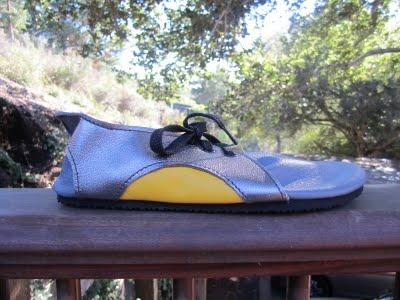 The first version I tested looked nothing like any Soft Star shoe I had ever seen. The colors were weird, the styling was odd, the construction was problematic, and the fit was relatively poor in a couple of key areas. Have I mentioned that I wasn't exactly wild about the new RunAmoc? Fortunately, this version quickly gave way to a prototype that at least looked something like its predecessor …
The first version I tested looked nothing like any Soft Star shoe I had ever seen. The colors were weird, the styling was odd, the construction was problematic, and the fit was relatively poor in a couple of key areas. Have I mentioned that I wasn't exactly wild about the new RunAmoc? Fortunately, this version quickly gave way to a prototype that at least looked something like its predecessor …
 … except that it had laces, which is one of the primary design changes on the new RunAmoc this year. The laces are great for improving the forefoot fit …
… except that it had laces, which is one of the primary design changes on the new RunAmoc this year. The laces are great for improving the forefoot fit …
 … but there was still a lot of modification at the heel over several versions. Initially there wasn't a heel support cup, and then there were two different styles … and I actually don't know what the final call on this will be. And this is only half of the heel puzzle …
… but there was still a lot of modification at the heel over several versions. Initially there wasn't a heel support cup, and then there were two different styles … and I actually don't know what the final call on this will be. And this is only half of the heel puzzle …
 … as the cut of the heel collar is quite a bit different on this version than the original RunAmoc. It has a high notch at the Achilles area, and tapers downward around the ankle bones on each side. Without the laces that wrap around the heel in the original RunAmocs, a secure fit through the heel has been one of my biggest concerns.
… as the cut of the heel collar is quite a bit different on this version than the original RunAmoc. It has a high notch at the Achilles area, and tapers downward around the ankle bones on each side. Without the laces that wrap around the heel in the original RunAmocs, a secure fit through the heel has been one of my biggest concerns.
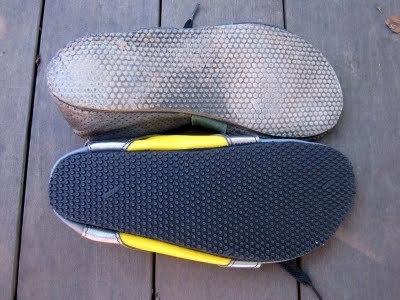 Original RunAmoc on top; first new version on bottom
Original RunAmoc on top; first new version on bottom
The toe box shape has also undergone a few variations, and I'm not sure what dimensions will be settled upon for the final version. Although the picture above doesn't reflect it, the new version is currently running a little bit narrower and a little more rounded than the original, but should still allow plenty of room for natural toe movement.
I'd like to say that the end result of all this is a product that completely blows me away – but truthfully, I'm still not 100% convinced that this new version is an improvement over the original. However, over the course of multiple changes, the new RunAmoc has gradually evolved into something that I'm confident enough to run an ultra in … which is exactly what I did at Woodside a few weeks ago, after which point we went back to the drawing board to address a couple more issues.
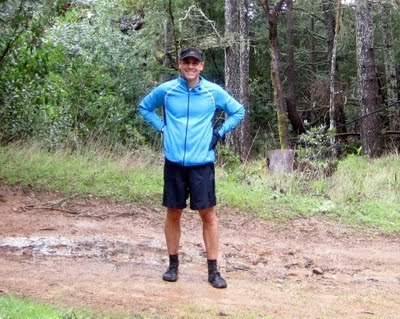 53 muddy miles in new RunAmocs
53 muddy miles in new RunAmocs
The best news in this whole story is that the original RunAmoc and RunAmoc Lites that I love so much aren't going anywhere; they'll still be available on the Soft Star website even as the new version is released, to accommodate folks like me who aren't quite ready to say goodbye to the moccasin we've fallen in love with. Before the new ones are released, Soft Star is soliciting feedback on the stock color they'll offer; go to their company blog or Facebook page to tell them whether you prefer silver or black.
 In the meantime, I'm continuing to test the new RunAmoc as well as the other model to be announced later; my hope is that by the time summer rolls around, I'll be able to say that one of these new offerings is something truly special.
In the meantime, I'm continuing to test the new RunAmoc as well as the other model to be announced later; my hope is that by the time summer rolls around, I'll be able to say that one of these new offerings is something truly special.
Get updates as soon as they're posted! Click here to subscribe to Running and Rambling.
Check out the Running Life book for a collection of our most popular columns.

This May, Soft Star is releasing a new version of their remarkably popular RunAmoc, which has been my favorite minimalist shoe ever since its debut approximately one year ago. You might think that since I loved the first version so much, the prospect of a new and improved model would have me giddy with excitement … but if you did, you'd be flat out wrong.
In fact, participating in this development process was somewhat distressing at times, partially attributable to the fact that I love the original RunAmoc so much. I didn't want my favorite shoe to be replaced, and the first models I tested were more than a little bit disappointing. Soft Star made a lot of changes to the original … and I honestly hated almost every single one of them.
To their credit, though, the elves at Soft Star were open to just about every piece of feedback I offered, and graciously hand crafted one pair after another to incorporate little changes here and there as we went along. As of right now, I've tested no fewer than 7 different pairs of moccasins so far – and I'm not certain that we're completely done yet.
Consequently, I'm going to wait on posting an official review until the final version - which has an official name, but I haven't seen it used publicly yet; I'll include it here as soon as it's green lighted - becomes available on the company website. For today, I thought it might be interesting to show a sampling of where we've been – because like I said, it's been kind of a strange ride. For example:
 The first version I tested looked nothing like any Soft Star shoe I had ever seen. The colors were weird, the styling was odd, the construction was problematic, and the fit was relatively poor in a couple of key areas. Have I mentioned that I wasn't exactly wild about the new RunAmoc? Fortunately, this version quickly gave way to a prototype that at least looked something like its predecessor …
The first version I tested looked nothing like any Soft Star shoe I had ever seen. The colors were weird, the styling was odd, the construction was problematic, and the fit was relatively poor in a couple of key areas. Have I mentioned that I wasn't exactly wild about the new RunAmoc? Fortunately, this version quickly gave way to a prototype that at least looked something like its predecessor … … except that it had laces, which is one of the primary design changes on the new RunAmoc this year. The laces are great for improving the forefoot fit …
… except that it had laces, which is one of the primary design changes on the new RunAmoc this year. The laces are great for improving the forefoot fit … … but there was still a lot of modification at the heel over several versions. Initially there wasn't a heel support cup, and then there were two different styles … and I actually don't know what the final call on this will be. And this is only half of the heel puzzle …
… but there was still a lot of modification at the heel over several versions. Initially there wasn't a heel support cup, and then there were two different styles … and I actually don't know what the final call on this will be. And this is only half of the heel puzzle … … as the cut of the heel collar is quite a bit different on this version than the original RunAmoc. It has a high notch at the Achilles area, and tapers downward around the ankle bones on each side. Without the laces that wrap around the heel in the original RunAmocs, a secure fit through the heel has been one of my biggest concerns.
… as the cut of the heel collar is quite a bit different on this version than the original RunAmoc. It has a high notch at the Achilles area, and tapers downward around the ankle bones on each side. Without the laces that wrap around the heel in the original RunAmocs, a secure fit through the heel has been one of my biggest concerns. Original RunAmoc on top; first new version on bottom
Original RunAmoc on top; first new version on bottomThe toe box shape has also undergone a few variations, and I'm not sure what dimensions will be settled upon for the final version. Although the picture above doesn't reflect it, the new version is currently running a little bit narrower and a little more rounded than the original, but should still allow plenty of room for natural toe movement.
I'd like to say that the end result of all this is a product that completely blows me away – but truthfully, I'm still not 100% convinced that this new version is an improvement over the original. However, over the course of multiple changes, the new RunAmoc has gradually evolved into something that I'm confident enough to run an ultra in … which is exactly what I did at Woodside a few weeks ago, after which point we went back to the drawing board to address a couple more issues.
 53 muddy miles in new RunAmocs
53 muddy miles in new RunAmocsThe best news in this whole story is that the original RunAmoc and RunAmoc Lites that I love so much aren't going anywhere; they'll still be available on the Soft Star website even as the new version is released, to accommodate folks like me who aren't quite ready to say goodbye to the moccasin we've fallen in love with. Before the new ones are released, Soft Star is soliciting feedback on the stock color they'll offer; go to their company blog or Facebook page to tell them whether you prefer silver or black.
 In the meantime, I'm continuing to test the new RunAmoc as well as the other model to be announced later; my hope is that by the time summer rolls around, I'll be able to say that one of these new offerings is something truly special.
In the meantime, I'm continuing to test the new RunAmoc as well as the other model to be announced later; my hope is that by the time summer rolls around, I'll be able to say that one of these new offerings is something truly special.Get updates as soon as they're posted! Click here to subscribe to Running and Rambling.
Check out the Running Life book for a collection of our most popular columns.

Published on April 09, 2011 20:29
Random Shots of Beauty
This week's RSOB wasn't taken from a trail run; truthfully, it wasn't even taken by me. Rather, it's a view of a place that's been on my mind quite often over the past few days:
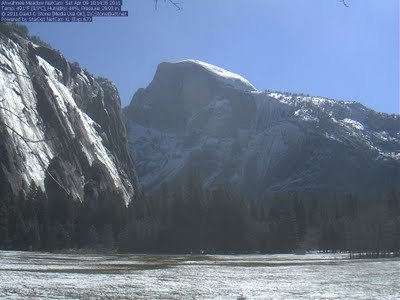 Yosemite Valley, as seen from the park's Ahwahnee Meadow webcam this morning. We have a family trip planned for later this month, but with the recent threat of a government shutdown, for a while there our chances looked pretty bleak. Needless to say, we're glad that Congress worked things out at least well enough to keep our favorite national park open.
Yosemite Valley, as seen from the park's Ahwahnee Meadow webcam this morning. We have a family trip planned for later this month, but with the recent threat of a government shutdown, for a while there our chances looked pretty bleak. Needless to say, we're glad that Congress worked things out at least well enough to keep our favorite national park open.
Now if someone could just do something about all that snow ...
Get updates as soon as they're posted! Click here to subscribe to Running and Rambling.
Check out the Running Life book for a collection of our most popular columns.

 Yosemite Valley, as seen from the park's Ahwahnee Meadow webcam this morning. We have a family trip planned for later this month, but with the recent threat of a government shutdown, for a while there our chances looked pretty bleak. Needless to say, we're glad that Congress worked things out at least well enough to keep our favorite national park open.
Yosemite Valley, as seen from the park's Ahwahnee Meadow webcam this morning. We have a family trip planned for later this month, but with the recent threat of a government shutdown, for a while there our chances looked pretty bleak. Needless to say, we're glad that Congress worked things out at least well enough to keep our favorite national park open.Now if someone could just do something about all that snow ...
Get updates as soon as they're posted! Click here to subscribe to Running and Rambling.
Check out the Running Life book for a collection of our most popular columns.

Published on April 09, 2011 10:09

